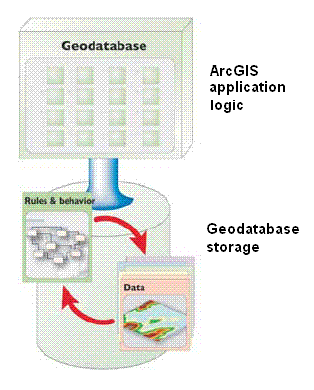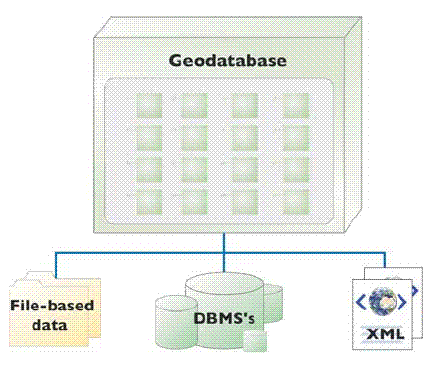
 |
The geodatabase is object-relational |
|
| Release 9.3 |    |
 Responsibility for management of geographic datasets is shared between the ArcGIS software and generic DBMS. Certain aspects of geographic dataset management, such as disk-based storage, definition of attribute types, associative query processing, and multiuser transaction processing, are delegated to the DBMS. The GIS application retains responsibility for defining the specific DBMS schema used to represent various geographic datasets and for domain-specific logic, which maintains the integrity and utility of the underlying records.
In effect, the DBMS is used as one of a series of implementation mechanisms for persisting geographic datasets. However, the DBMS does not fully define the semantics of the geographic data. This could be considered a multitier architecture (application and storage), where aspects related to data storage and retrieval are implemented in the data storage (DBMS) tier as simple tables, while high-level data integrity and information processing functions are retained in the application and domain software (ArcGIS).
The geodatabase is implemented using the same multitier application architecture found in other advanced DBMS applications. The geodatabase objects are persisted as rows in DBMS tables that have identity, and the behavior is supplied through the geodatabase application logic.
All ArcGIS applications interact with this generic GIS object model for geodatabases, not with the actual SQL-based DBMS instance. The geodatabase software components implement behavior and integrity rules implicit in the generic model and translate data requests to the appropriate physical database design. ArcSDE software technology provides a gateway for ArcGIS to interact with the DBMS.
Responsibility for management of geographic datasets is shared between the ArcGIS software and generic DBMS. Certain aspects of geographic dataset management, such as disk-based storage, definition of attribute types, associative query processing, and multiuser transaction processing, are delegated to the DBMS. The GIS application retains responsibility for defining the specific DBMS schema used to represent various geographic datasets and for domain-specific logic, which maintains the integrity and utility of the underlying records.
In effect, the DBMS is used as one of a series of implementation mechanisms for persisting geographic datasets. However, the DBMS does not fully define the semantics of the geographic data. This could be considered a multitier architecture (application and storage), where aspects related to data storage and retrieval are implemented in the data storage (DBMS) tier as simple tables, while high-level data integrity and information processing functions are retained in the application and domain software (ArcGIS).
The geodatabase is implemented using the same multitier application architecture found in other advanced DBMS applications. The geodatabase objects are persisted as rows in DBMS tables that have identity, and the behavior is supplied through the geodatabase application logic.
All ArcGIS applications interact with this generic GIS object model for geodatabases, not with the actual SQL-based DBMS instance. The geodatabase software components implement behavior and integrity rules implicit in the generic model and translate data requests to the appropriate physical database design. ArcSDE software technology provides a gateway for ArcGIS to interact with the DBMS.
 The separation of geodatabase logic from storage enables open support for numerous file types, DBMSs, and XML. For example, a very exciting capability to access almost any feature and tabular data format is provided by the Data Interoperability Extension to ArcGIS. This extension provides a gateway to read and work with dozens of data formats using the geodatabase logic.
The separation of geodatabase logic from storage enables open support for numerous file types, DBMSs, and XML. For example, a very exciting capability to access almost any feature and tabular data format is provided by the Data Interoperability Extension to ArcGIS. This extension provides a gateway to read and work with dozens of data formats using the geodatabase logic.